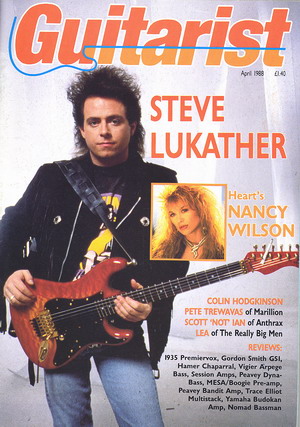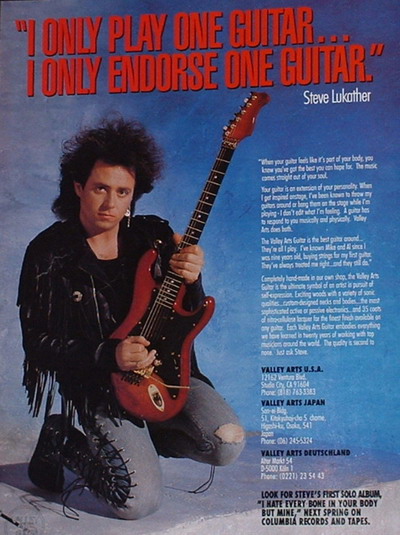Steve Lukather Model with Steve Lukather Signature Sunburst,EMG, ALL ORIGINAL With Case RARE, EX
With the introduction of Valley Arts, Gibson has re-created
the legendary custom guitar line and "pro shop" guitar store whose client list
was once a who's who of Los Angeles guitarists, from Larry Carlton to Lee
Ritenour to Tommy Tedesco. The new Valley Arts facility, which opened in
November 2002 in Nashville with the dropping of a grand piano from a helicopter,
includes a full-line guitar store, a guitar repair service and a manufacturing
facility, just like the original business. Even the original owners, Mike
McGuire and Al Carness, are on hand - McGuire as operations manager of Gibson's
Custom division and Carness as Valley Arts product specialist - to ensure that
the spirit of Valley Arts carries on.
Valley Arts had its origins in a music store owned by guitar teacher Duke
Miller, whose students included McGuire and Carness. "Duke was more than a
teacher," McGuire said "He was more like a mentor, and he really nursed me along
through the years. He got me my first teaching job at a store in Pacoima,
California, called Music World. I was 15 at the time. Eventually I started
teaching and working for Duke at his place, and at that time we started a little
store, Duke Miller's Guitar Center in North Hollywood."
In the late 1960s, McGuire went into the U.S. Navy, and while he was in the
service Miller asked him if he wanted to buy into the business. McGuire accepted.
In the meantime, Al Carness had been going to school and playing guitar in a
band that was billed as the Surfaris (of "Wipe Out" fame). They were not the
Surfaris, actually, but the agent for the Surfaris routinely double-booked the
band and then sent Carness' group out as impersonators. Around 1969, Carness
joined with McGuire and Miller in the store partnership, and by 1971, Miller was
ready to move on.
"Duke was really an educator," McGuire said. "He wanted to write books, and he
accepted a teaching position at the University of Southern California as jazz
music director, so at that time he sold the rest of the business to Al and Me.
After about a year we changed it from Duke Miller Guitar Center to Valley Arts."
"It was a very small music store," Carness recalled. "It was mostly teaching,
with some repair. Mike kind of gravitated toward repair and I gravitated toward
the business side. Everything was always focused on the player and the service."
Around 1973, they moved from the original location on Laurel Canyon Blvd. to
Ventura Blvd. Initially they focused on teaching, and the teaching staff
eventually grew to include 12 full-time teachers. McGuire also began learning
how to repair guitars.
"I started going over to a guy named Jack Wilock," he recalled, "who was
absolutely the best old repair guy in the world. I would go over there every
morning and he would teach me stuff. I would clean up his shop and he would show
me stuff and let me work on some things. Then I would go back to Valley Arts,
and Al and I would open it up. I did that for several years, all the time taking
in some repair work at the shop. All the time it kept evolving.
"We started getting a good reputation for repair and modifications," McGuire
added. "I think one of the major turning points was when Larry Carlton walked in
the store. I remember he brought in an old Gibson SG. I knew that it wasn't his
main axe. Everybody knew what he played. I think it was kind of a test. He said,
'I'd like to get this refretted,' and he sat on the stool and waited. Talk about
being intimidated.
"Larry really helped me understand what was really needed in a good guitar tech
or repair guy. He explained to me that when his guitar was in that shop, he wasn't
making any money with it. He needed it done now and done right. I think that was
what made me so conscious of details. Larry could hear things that I couldn't
hear. 'You hear this? I can't have that.' That kind of thing.
"And then things mushroomed. Having Larry come in, the word spread pretty
quickly. Every Saturday, the guys would come up in the repair shop above the
store. That was like the Saturday tradition - pizza at Valley Arts." The Valley
Arts clientele grew to include Tommy Tedesco, Steve Lukather, Robben Ford, Mitch
Holder, Mundell Lowe, Al Viola and one of McGuire's main influences, Duane Eddy.
Lee Ritenour, another of Duke Miller's former students, was a frequent visitor
to Valley Arts, and he had the distinction of being the champion "sack reader."
The store's paper sacks were printed with a piece of music, and they offered a
free set of strings to anyone who could sight-read it. "Lee burned it," McGuire
said. "Nobody could play that. Tedesco, who's one of the monsters, could kind of
fumble through it, but Ritenour was on it. I was standing right there, I can
remember it vividly like it was yesterday."
Ritenour, who now has his own Gibson Custom Shop model, left a lasting Valley
Arts memory with Al Carness, too. "We did a little get-together at the store,
and Lee and I played together," he said. "I had learned this really cool
chord-melody version of 'Shadow of Your Smile.' I thought I'd really impress
Lee, but he just blew me away."
Around 1977, McGuire built his first guitar from scratch. It was similar to a
Fender Stratocaster, but with a quilted maple body and a birdseye ebony
fingerboard. He thinks Larry Carlton ended up with it. By 1983, demand for new
Valley Arts guitars had grown to the point that McGuire opened a separate
manufacturing facility on Vose St. (just south of Sherman Way in North
Hollywood) that eventually employed 35 people.
"We really developed a lot of things," he said. "I had the opportunity to try
every single pickup going. I had a quick disconnect in Larry Carlton's guitar so
we could put these things in and out and try them. We came out with the Steve
Lukather model and the Larry Carlton model. The Custom Pro model was the top of
the line. You could pretty much get it made any way you wanted it. We came out
with the California Pro. These were pretty much full-sized Strats, mostly in
pastel colors - faded coral, lemony yellow, stuff like that. But still everybody
was wanting something less expensive, so we finally came out with the Standard
Pro. We also did a version of a Telecaster, with a carved top and herringbone
binding that we called the Mickey, after my son Mickey, who was with me doing
the painting. And still is." (Mickey McGuire currently works in the Custom
Shop's finishing department.)
Valley Arts also developed a 7/8-size guitar, initially in response to guitarist
Jay Graydon's push for a Strat with a Gibson scale (24 ¾ inches rather than the
25 ½ inch Fender standard). All of the options in the new Valley Arts line are
available on a 7/8-size guitar.
Although the Valley Arts name came to be synonymous with custom guitars, the "cash
cow," according to McGuire, was the retail store. On the day after
Christmas,1990, the cash cow was destroyed by an arsonist. "We were right next
door to a Pier One import store," McGuire said. "This bum was walking along and
threw a Molotov cocktail into Pier One and burned it down. We were horribly
underinsured - about 20 cents on the dollar. It was devastating because we were
right in the midst of expanding production and we needed the money badly."
Unable to recover, McGuire and Carness sold the store to a San Francisco chain
and in mid-1992 took on a partner in the manufacturing business. Samick, the
giant Korean instrument maker, bought 50 percent of Valley Arts, leaving McGuire
and Carness 25 percent each. McGuire became a consultant and was supposed to
spend six months of every year in Korea. "Well, after the first trip over there
it didn't take me long to figure out, man, that really sucked," he said. "It was
like purgatory for me, because I had a family. It was just a nightmare."
McGuire had known Gibson owners Henry Juszkiewicz and Dave Berryman since their
acquisition of Gibson in 1986, and he ran into Berryman in Korea, where Berryman
was on a buying trip for Gibson's Epiphone brand. Gibson was getting ready to
expand the Custom Shop into a standalone division, and McGuire came on board as
production manager, moving to Nashville in October 1993.
Carness had a similar experience with his new partner. "They downsized my
position," he said. "I was in charge of international sales, and they wanted me
to be a Samick sales rep." When he turned that down, he was offered a job in the
shipping department. By mid-1993 he had left Samick to work for Gibson as sales
rep for the southern California territory. In 1996 he moved to Portland, OR, to
work for AMIC, which handled Akai, Jackson and Charvel products. In October 2002
he moved to Nashville to join Gibson's bluegrass division.
Coincidentally, Gibson had been working to acquire Valley Arts. On December 3,
2002, less than two months after Carness' arrival, Gibson dropped a piano from a
helicopter into a parking lot in downtown Nashville, marking the opening of the
new Valley Arts store. (The piano drop also symbolized the end of the old piano
era as it commemorated the opening of Gibson's new Baldwin Piano Showcase,
located a stone's throw away from Valley Arts.)
The new retail store and the repair shop (staffed by experienced Gibson warranty
repairmen) immediately gave Nashville a taste of the old Valley Arts. The first
new Valley Arts guitars were shown at the NAMM show in January 2003 in Anaheim,
and Nashville session guitarist Brent Mason has recently joined the long list of
great guitarists who have ordered their own custom Valley Arts instruments. And
the spirit of the original pizza Saturdays will soon be revived when the top
floor of the Valley Arts facility is finished out with a restaurant and music
venue.
http://www.youtube.com/watch?v=-V08ztbA-7k
http://www.youtube.com/watch?v=W-5KSOTFp08
Guitar was built on 3.12.1991 with SA1 SA1 and 85 EMG pick-ups
Lukathers autograph is from 2005 when he played in Pratteln Switzerland




